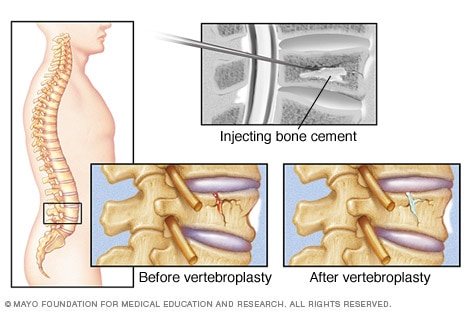Overview
Vertebroplasty procedure

Vertebroplasty procedure
In vertebroplasty, bone cement is injected into fractured vertebrae to stabilize the spine and relieve pain.
Vertebroplasty is a treatment that injects cement into a cracked or broken spinal bone to help relieve pain.
Spinal bones are called vertebrae. Vertebroplasty is used most often to treat a type of injury called a compression fracture. These injuries are often caused by osteoporosis, a condition that weakens bone. Osteoporosis is most common in older people. Compression fractures also may be caused by cancer that spreads to the spine.
Many compression fractures don't cause any symptoms and don't need any treatment. But if you have persistent or severe pain, vertebroplasty might help.
Products & Services
Why it's done
Vertebroplasty can relieve pain caused by compression fractures in the spine. Compression fractures most often happen when osteoporosis or cancer weakens the spinal bones.
Weakened spinal bones can crack or break into many pieces. The fractures can occur during activities that wouldn't usually break a bone. Examples include:
- Twisting.
- Bending.
- Coughing or sneezing.
- Lifting.
- Rolling over in bed.
Risks
Vertebroplasty involves injecting a type of bone cement into a broken spinal bone. In a similar treatment, called kyphoplasty, a balloon is first inserted into the spinal bone. The balloon is inflated to make more space inside the bone. Then the balloon is deflated and removed before the cement is injected.
Risks associated with either procedure include:
- Cement leakage. Part of the cement can leak from the spinal bone. This can cause new symptoms if the cement presses on the spinal cord or nerves. Tiny pieces of this leaked cement also can enter the bloodstream and move to the lungs, heart, kidneys or brain. Very rarely, this can damage these organs and sometimes even cause death.
- Additional fractures. These procedures might increase the risk of fractures in neighboring spinal bones.
- Bleeding or infection. Any needle-guided procedure has a small risk of causing bleeding. There is also a small risk of the site becoming infected.
How you prepare
You will need to avoid eating or drinking for several hours before vertebroplasty or kyphoplasty. If you take daily medicines, you may be able to take them the morning of the procedure with small sips of water. You may need to avoid taking blood thinners for a few days before the procedure. Follow your healthcare professional's instructions.
Wear comfortable clothing and leave your jewelry at home. Most people go home the same day. You should arrange in advance for someone to drive you home.
What you can expect
During the procedure
You'll wear a hospital gown. You'll likely have a flexible narrow tube inserted into a vein in your arm or hand.
The type of anesthesia you receive depends on the type of procedure and the number of spinal bones involved. General anesthesia keeps you in a sleeplike state during the procedure. Most people, though, just need to be sedated. Sedation medicines make you relaxed and sleepy.
You'll lie face down and get numbing shots in your skin. Vertebroplasty usually takes about an hour. It may take longer if more than one spinal bone needs treatment.
Special types of X-rays or CT scans are taken during the procedure, to guide the needle into the spinal bone and watch the cement as it is injected. The cement hardens within 20 minutes.
If the fracture was caused by cancer, a small sample of bone tissue may be removed for testing. Radiation treatment of the cancer in the bone also may happen before or after the procedure.
After the procedure
Most people who have vertebroplasty or kyphoplasty go home the same day. You'll need to arrange in advance for someone to drive you home.
The place on your back where the needles were inserted might be sore for a few days. An ice pack can help relieve this pain. Protect your skin from the ice with a cloth. Use ice for about 15 minutes every hour.
You should follow all instructions from your healthcare professional and avoid heavy lifting for at least six weeks.
Results
Study results have been mixed as to the effectiveness of vertebroplasty. Some early studies showed that vertebroplasty worked no better than a shot that didn't provide a treatment, called a placebo. However, both vertebroplasty and the placebo shot relieved pain.
Newer studies show that vertebroplasty and kyphoplasty often relieve pain from compression fractures for at least a year.
A compression fracture is a sign of weakened bones. People who have one compression fracture have a higher risk of more fractures in the future. That's why it's important to also diagnose and treat the cause of the bone weakness.
Oct. 15, 2024